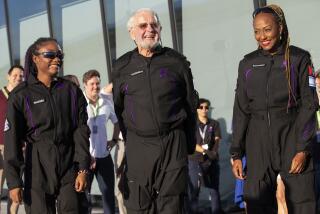Comet: It’s a Once-in-a-Lifetime Opportunity
- Share via
For only $10,220, you can have a penthouse suite aboard the Royal Viking Star and your tour guide will be, as an advertising brochure puts it, “the world famous TV star and lecturer Carl Sagan.”
If your budget will only allow about a third that amount, you can spend two weeks in Australia with the Astronomical Society of the Pacific as your host.
There are also lots of other tours--at least 45 already organized--aimed at giving you the best view of next year’s passage of Halley’s Comet, a one-time traumatizer of Earthlings that has been reduced to a mere obsession.
Along the way, some telescope manufacturers will offer to sell you telescopes that will probably prove disappointing. You may travel to the southern fringes of the Earth, only to find the view lessened by local weather conditions. And even if everything goes perfectly, in the end you may be very disappointed in what you will see.
All that not withstanding, however, Halley’s Fever is catching on.
‘Going First Class’
“We’re into it,” said Bill Scheufler, president of Draper World Travel of San Diego, which has arranged four cruises to the South Pacific aboard the Royal Viking Star. “We’re going first class.”
In addition to Sagan, the noted Cornell astronomer, Scheufler’s group has lined up a number of other reputable astronomers to serve as “enhancement lecturers” during the cruises. Fred Whipple, probably the most respected expert on comets in the country and the former director of the Smithsonian Astrophysical Observatory, will serve in a similar capacity with Sun Line Cruises, based in New York.
Many other astronomers said they had been asked by travel agencies to serve as guides, and some said they expected to yield to the temptation, although that will draw them away from their research centers when the time could be the best for observing Halley’s.
“I’ve never taken a boondoggle,” said one well-known scientist, who asked that his name not be used, “but I’ve never taken a cruise either. I’m going to do it.”
Southern View Best
The “once-in-a-lifetime experience,” as one brochure puts it, lends itself especially well to promotion by travel agencies because the best view will be in the Southern Hemisphere, where the comet will be higher in the sky.
Scheufler said his firm has just begun advertising the tours aboard the Royal Viking Star, which range in price from $2,828 to more than $10,000.
“I’m assuming it will sell out in four or five weeks,” Scheufler said, adding that the ship, which can handle 600 passengers, rarely sells out for spring cruises in the South Pacific.
“It’s very appealing, especially when you realize that by the time Halley’s Comet comes around again (in 76 years), you will be either disinterested or dead,” he said.
Stephen Edberg, an astronomer with the Jet Propulsion Laboratory in Pasadena who is serving as coordinator of amateur observations for the International Halley Watch, said that for best viewing, people should “pick the southern continent of your choice.”
The comet will be higher in the sky when it passes over the Southern Hemisphere, so the view will be “longer and cleaner.” He said urban areas anywhere are out, because light pollution will overwhelm the comet, and “some tropical regions could be too hazy.”
Binoculars Will Help
Most astronomers say a good pair of binoculars will help, but nearly all warn that the casual viewer who spends a lot of money on a celestial telescope is probably going to be disappointed.
For the unprofessional, the view through a telescope will yield “a fuzzy ball in the eyepiece,” Edberg said.
“It takes time to learn what you are seeing.”
Of course, it won’t be necessary to go all the way to the South Pacific to see the comet, although the view this far north will be much less dramatic. A trip to the desert will probably do nicely, astronomers say.
“At its brightest, it will be like one of the stars in the Big Dipper,” said G. Edward Danielson, a Caltech astronomer. “It will be a fun thing for a lot of people.”
More to Read
Sign up for The Wild
We’ll help you find the best places to hike, bike and run, as well as the perfect silent spots for meditation and yoga.
You may occasionally receive promotional content from the Los Angeles Times.






